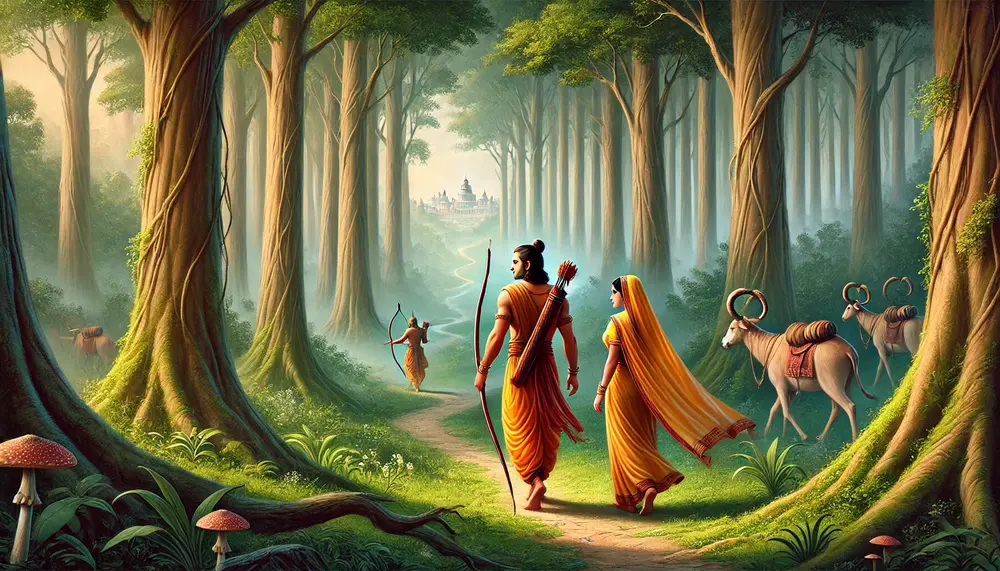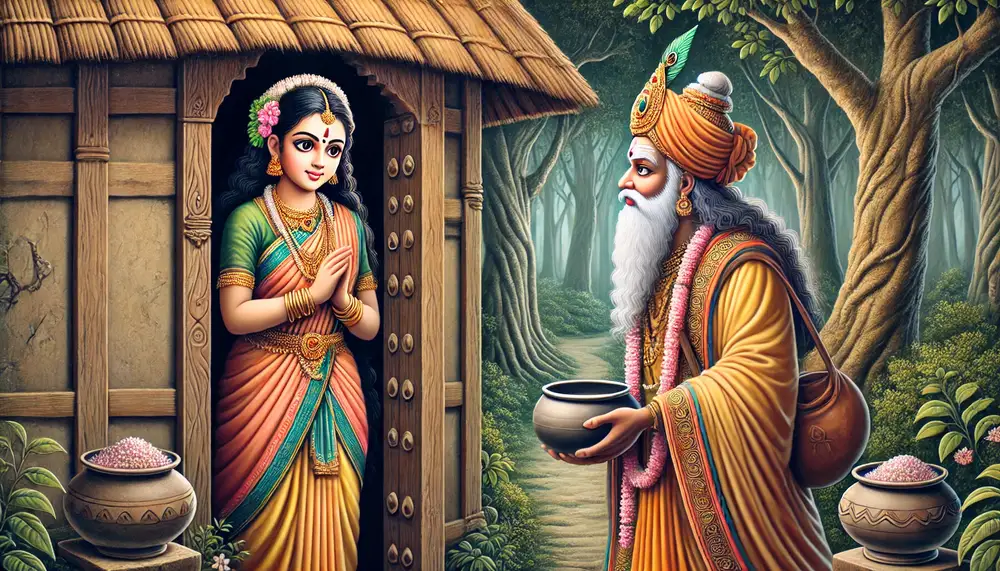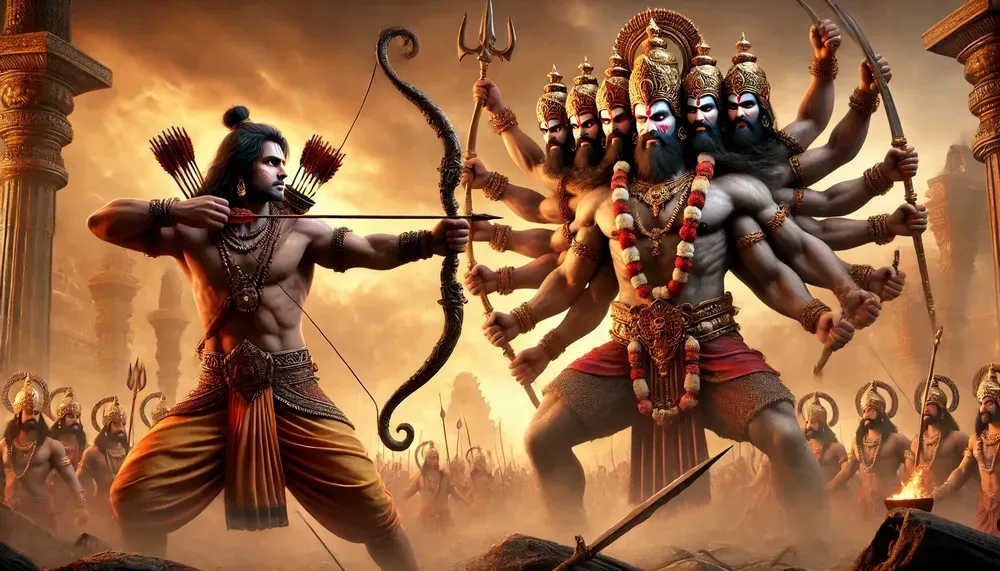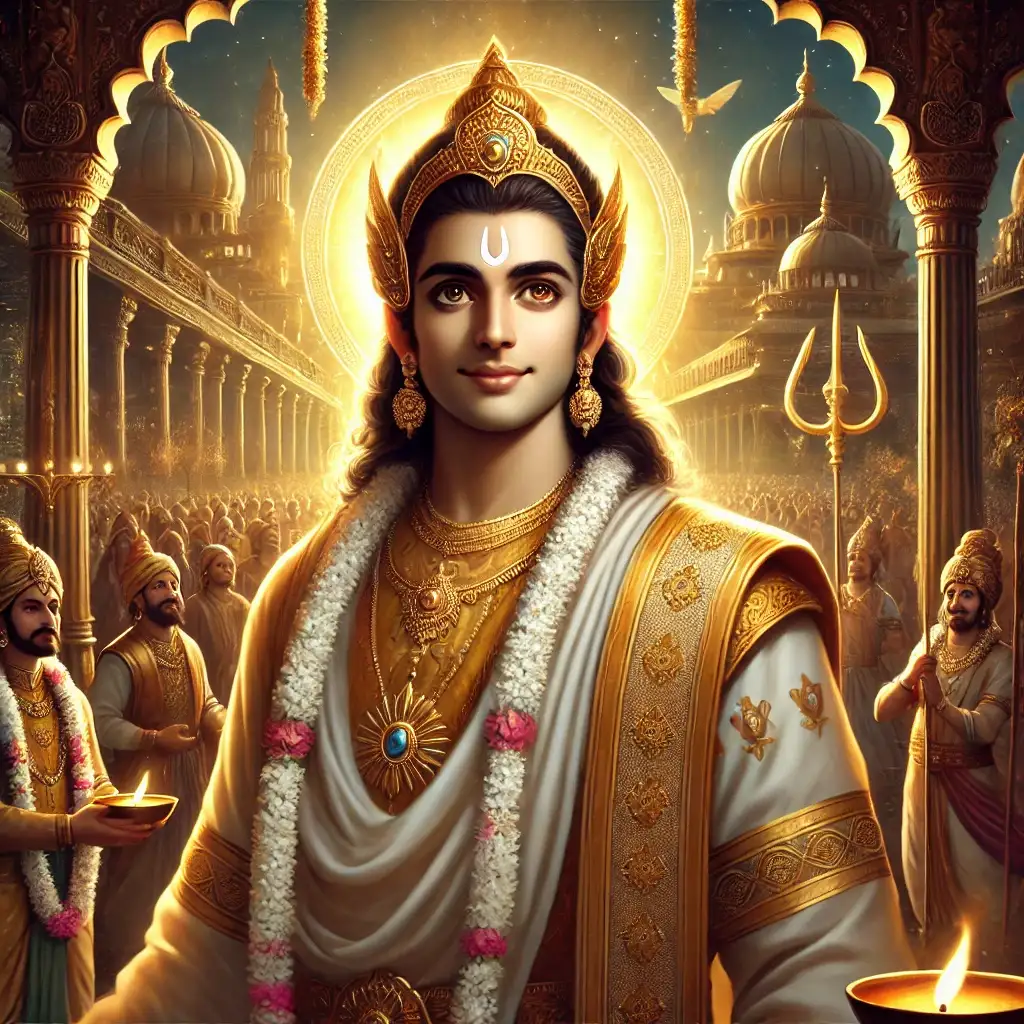As we approach the celebration of Diwali, let us reflect on the profound story that lies at its heart. Shree Ram's return to Ayodhya after 14 years of exile is not just a historical account but a timeless narrative that continues to inspire millions. This ancient story, deeply woven into the fabric of Hindu culture, impacts how we understand hope, righteousness, and the triumph of good over evil.
We will explore the epic journey of Shree Ram, from his exile to his victorious return to Ayodhya. We will go through the key events: Shree Ram's banishment, Mother Sita's abduction, the great battle, and finally, the homecoming that sparked the tradition of lighting oil lamps. This story, set in the holy month of Kartik, is not just about a festival; it’s about how one event became a symbol of hope and joy for an entire civilization. Let us dive into this captivating tale and discover why Diwali in Ayodhya holds such significance even today.
The Story of Shree Ram's Exile
The story of Shree Ram's exile is a pivotal moment in the Shree Ramayan, showcasing the power of duty, sacrifice, and unwavering devotion to righteousness. This chapter in Shree Ram's life began with a promise made by his father, King Dashrath, setting in motion a series of events that would shape the destiny of Ayodhya and its people.

King Dashrath's Promise
King Dashrath, a valiant warrior who had aided the celestial god Indra in battles against demons, owed a debt of gratitude to his wife Kaikeyi. During a fierce battle, Kaikeyi had saved Dashrath's life not once, but twice. In return for her bravery, the king promised to grant her two wishes, whenever she chose to ask for them [1].
Years later, on the eve of Shree Ram's coronation as the king of Ayodhya, Kaikeyi decided to claim her boons. Influenced by her conniving maid Manthara, she demanded that Bharat, her son, be crowned king instead of Shree Ram and that Shree Ram be exiled to the forest for fourteen years [2].
Shree Ram's Compliance
When Shree Ram learned of his father's promise and Kaikeyi's demands, he demonstrated extraordinary compliance and respect for his father's word. Despite being the rightful heir to the throne, Shree Ram willingly accepted exile, showcasing his unwavering commitment to upholding dharma (righteousness) and honoring his father's promise [3].
Shree Ram's response to this sudden turn of events was remarkable. He said to his stepmother, "I gladly obey father's command. Why, I would go even if you ordered it" [4]. This act of selflessness and adherence to duty became a defining moment in the story of Shree Ram, setting an example of filial piety and moral integrity.
14 Years in Exile
As Shree Ram prepared for his departure, his wife Mother Sita, and brother Lakshman insisted on accompanying him into exile. Mother Sita, embodying the ideal of a devoted wife, said, "As shadow to substance, so is a wife to a husband. Is it not the wife's dharma to be at her husband's side? Let me walk ahead of you so that I may smooth the path for your feet." [4]
The trio's journey into the forest marked the beginning of a 14-year period filled with challenges & adventures. They first arrived in Chitrakoot, a serene region along the banks of the Mandakini River. Here, Shree Ram sought the guidance of the renowned sage Bharadwaj, whose ashram provided sanctuary and spiritual solace during this challenging time. [3]
Throughout their exile, Shree Ram, Mother Sita, and Lakshman encountered various individuals who would play crucial roles in their journey. They also faced numerous trials, including encounters with demons (rakshasas) who disturbed the sages in their religious rituals and meditation. [4]
Lesson
Shree Ram’s Exile serves as a timeless reminder of the importance of duty, sacrifice, and unwavering devotion to principles of righteousness. It demonstrates how even in the face of great personal loss, adherence to dharma can lead to profound spiritual growth and ultimately, triumph over adversity.
Mother Sita's Abduction and the Search
The story of Mother Sita's abduction is a pivotal moment in the Shree Ramayan setting in motion a series of events that would ultimately lead to the triumph of good over evil. As we delve into this crucial part of the tale, we will explore how Ravan's deception, Hanuman's role, and the building of alliances played significant parts in the search for Mother Sita.

Ravan's Deception
Ravan, the mighty king of Lanka, devised a cunning plan to abduct Mother Sita. He sought the help of Marich, a demon capable of transforming into any form. Together, they crafted a scheme to lure Shree Ram away from Mother Sita. Marich transformed into a beautiful golden deer and wandered near their hut, enchanting Mother Sita with its beauty.
Captivated by the deer's allure, Mother Sita requested Shree Ram to capture it for her. Despite his initial hesitation, Shree Ram set out to fulfill Mother Sita's wish, leaving Lakshman behind to protect her. This moment of separation provided Ravan with the opportunity he had been waiting for.
Later, a sound came from the inner forest as if Shree Ram was calling Lakshman to help him. It was a scream from Marich to move Lakshman away from Sita’s protection. Lakshman was unconvinced by the sound as he could never believe that Shree Ram was in trouble. However, after continuous insistence from Mother Sita, he had no option but to go leaving her alone.
Disguised as a humble sage, Ravan approached Mother Sita and asked for alms. Mother Sita, with her compassionate nature, stepped out to offer food. In that instant, Ravan revealed his true form and seized Mother Sita, taking her away in his flying chariot, Pushpak. The forest echoed with Mother Sita's cries for help as Ravan carried her off to Lanka.
Shree Hanuman's Role
When Shree Ram and Lakshman returned to find Mother Sita missing, their hearts filled with worry and determination to rescue her. It was at this critical juncture that Hanuman ji, the greatest devotee of Shree Ram, entered the story. Hanuman's role in the search for Mother Sita was crucial and showcased his loyalty, bravery, and resourcefulness. Hanuman, known for his strength and wisdom, was selected for the task of searching for Mother Sita in Lanka. He possessed all the qualifications to be Shree Ram's emissary, being strong, steady, and intelligent. With unwavering resolve, Hanuman set out to find Mother Sita at any cost, approaching the task with single-minded focus and dedication.
Building Alliances
As the search for Mother Sita intensified, Shree Ram and Lakshman began building alliances that would prove instrumental in their quest. They encountered Sugriv, who had been deposed by his ruthless brother, Bali. Shree Ram promised to help Sugriv and defeated his brother in exchange for assistance in finding Mother Sita.
This alliance with Sugriv was crucial, as it placed Sugriv's powerful army at Shree Ram's disposal, including the resourceful general, Hanuman. The partnership between Shree Ram and Sugriv's forces would prove vital in the eventual rescue of Mother Sita and the defeat of Ravan.
As the search continued, Hanuman's determination never wavered. After a rigorous search, he finally found Mother Sita in the Ashok Garden, surrounded by demonesses. This discovery marked a turning point in the Shree Ramayan, setting the stage for the epic battle that would follow.
Lesson
The story of Mother Sita's abduction and the subsequent search highlights the importance of loyalty, perseverance, and the power of alliances in the face of adversity. It serves as a reminder of the enduring spirit of hope that is celebrated during Diwali in Ayodhya and across the Hindu world.
The Battle for Dharma
The battle for dharma, or righteousness, reached its pinnacle as Shree Ram and his allies prepared to face Ravan and his demon army. This epic confrontation, central to the celebration of Diwali in Ayodhya, symbolizes the eternal struggle between good and evil.

Crossing the Ocean
To reach Lanka, Shree Ram and his army had to overcome a significant obstacle - the vast ocean. With divine intervention and the help of his loyal followers, a remarkable solution was devised. Nal and Nil, two skilled monkey engineers, constructed a bridge known as Shree Ram Setu, which later came to be called Adam's Bridge.
This extraordinary feat of engineering involved writing "Shree Ram" on each boulder before casting it into the sea. Miraculously, these stones floated, allowing the army to cross the waters. The construction of this bridge not only showcases the devotion of Shree Ram's devotees but also highlights the power of faith and unity in overcoming seemingly insurmountable challenges.
Vibhishan's Support
In a crucial turn of events, Vibhishan, Ravan's own brother, chose to support Shree Ram in this battle for dharma. His decision to align with righteousness over family loyalty played a significant role in the outcome of the war. Vibhishan's knowledge of Ravan's strengths and weaknesses provided Shree Ram with strategic advantages, ultimately contributing to the victory of good over evil.
Vibhishana's choice to stand for truth and justice, even at the cost of opposing his own brother, serves as a powerful reminder that dharma should always take precedence over personal relationships when they conflict with righteousness.
Shree Ram's Victory
The final confrontation between Shree Ram and Ravan was a battle of epic proportions. Shree Ram, embodying righteousness, and divine power, faced the formidable demon king who had been granted numerous boons by the gods. The fight was not merely a test of physical strength but also a battle of wits and divine intervention.
Shree Ram's unwavering devotion to dharma and the blessings he received from various gods and sages empowered him throughout the battle. Even when faced with Ravan's regenerating heads and arms, Shree Ram remained composed and sought wisdom to overcome these challenges.
In the end, it was Shree Ram's adherence to dharma and his divine knowledge that led to Ravan's defeat. By targeting Ravan's navel - the one part of his body not protected by boons - Shree Ram brought an end to the demon king's reign of terror. This victory not only rescued Mother Sita but also restored balance and righteousness to the world, paving the way for Shree Ram's triumphant return to Ayodhya and the celebration of Diwali.
Lesson
The epic battle between Shree Ram and Ravan emphasizes the supremacy of righteousness (dharma) and the importance of faith & unity in overcoming challenges. It teaches that true strength lies in adhering to moral values, even when faced with formidable obstacles, a principle celebrated during Diwali as the victory of good over evil.
Shree Ram's Return: Symbol of Hope for Ayodhya
The return of Shree Ram to Ayodhya after 14 years of exile marked a momentous occasion that has been celebrated for centuries as Diwali. This joyous homecoming symbolized the triumph of good over evil and brought renewed hope to the people of Ayodhya.

Preparations for Return
As news of Shree Ram's victory over Ravan spread, the citizens of Ayodhya began preparing for his return with great enthusiasm. The entire city was decked out in anticipation of welcoming their beloved prince. People cleaned their homes, decorated the streets, and gathered to discuss the grand preparations.
The First Diwali
The first Diwali in Ayodhya was a sight to behold. As Shree Ram, Mother Sita, and Lakshman approached the city, the people lit thousands of earthen lamps (diyas) to illuminate their path. The city was bathed in a warm, golden glow, symbolizing the light of knowledge dispelling the darkness of ignorance. This tradition of lighting oil lamps during Diwali continues to this day, with Ayodhya setting world records for the number of diyas lit along the ghats of the Sarayu river [5].
Establishment of Ram Rajya
Upon his return, Shree Ram established Ram Rajya, an ideal form of governance that has become synonymous with just and righteous rule. In Ram Rajya, there was no poverty, pain, or discrimination. Justice was swift and accessible to all, regardless of their social status [6]. This concept of Ram Rajya continues to inspire political and social ideals in India, serving as a benchmark for good governance.
Hope for Justice, Love, and Harmony
The return of Shree Ram to Ayodhya during the auspicious month of Kartik brought with it a renewed sense of hope for justice, love, and harmony.
The celebration of Diwali in Ayodhya continues to be a symbol of hope and renewal. Each year, as the city lights up with millions of diyas, it reminds us of the eternal message of the Shree Ramayan - the triumph of light over darkness, good over evil, and knowledge over ignorance. The festival not only commemorates the return of Shree Ram but also rekindles the hope for a just and harmonious society, making Ayodhya Diwali a truly special celebration.
Lesson
Shree Ram's return to Ayodhya wasn't just a celebration; it was a powerful lesson in loyalty and devotion. The people's unwavering faith in their prince, despite his long absence, showcased the deep bond between a leader and his subjects. This devotion has become an integral part of the Diwali celebrations in Ayodhya, reminding us of the importance of staying true to our values and beliefs.
Conclusion
The timeless story of Shree Ram's return to Ayodhya has a profound influence on the celebration of Diwali, reminding us of the enduring power of hope, righteousness, and the triumph of good over evil. This story, woven into the fabric of Hindu culture, continues to inspire millions, teaching valuable lessons about duty, sacrifice, and unwavering devotion to principles. As we light our Diwali lamps each year, we are not just celebrating a festival; we are keeping alive a tradition that symbolizes the light of knowledge dispelling the darkness of ignorance.
The story of Shree Ram and the celebration of Diwali in Ayodhya serve as a beacon of hope for justice, love, and harmony in our world today. They remind us of the importance of staying true to our values and the power of unity in overcoming challenges. In the end, the message of Diwali encourages us to light the lamp of knowledge within ourselves and to spread the warmth of love and compassion to those around us.
Call to Action
To dive deeper into these timeless teachings, consider subscribing to Swami Mukundananda's YouTube channel and visiting the Radha Krishna Temple of Dallas with your family if you are seeking spiritual connection or cultural enrichment.
FAQs
- What is the significance of Diwali in relation to Shree Ram? Diwali, also known as the Festival of Lights, is significantly important as it celebrates the return of Shree Ram to Ayodhya after his 14-year exile and his victory over the demon king Ravan. This festival symbolizes the victory of good over evil and light over darkness.
- Can you explain the story of Shree Ram related to Diwali? Diwali commemorates the day when Shree Ram, along with his wife Mother Sita and brother Lakshman, returned to Ayodhya after 14 years of exile. During this period, they faced numerous hardships, including the abduction of Mother Sita by the demon king Ravan, which eventually led to a grand battle.
- How does the Shree Ramayan connect to Diwali? The Shree Ramayan narrates the epic tale of Shree Ram's return to Ayodhya, which is celebrated as Diwali. This return marks Shree Ram's victory over Ravan and symbolizes the triumph of good over evil.
- What historical significance does Diwali hold? Historically, Diwali is a reflection of India's rich past, teaching the values of life through the story of Prince Shree Ram. This festival marks his return to Ayodhya with his wife Mother Sita and brother Lakshman after defeating Ravan and completing their long exile, embodying hope and the victory of righteousness.





